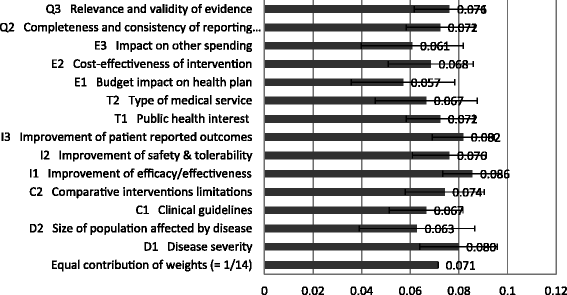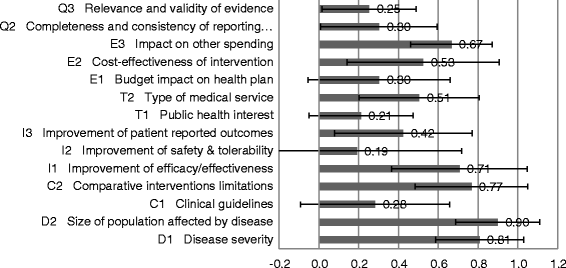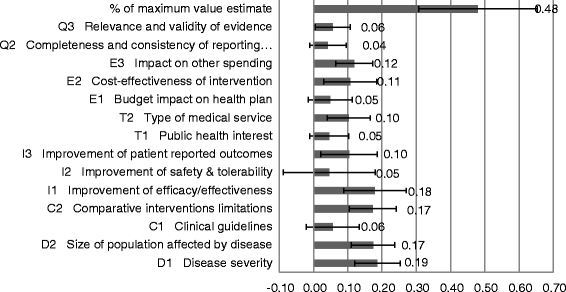Exploring the perspectives and preferences for HTA across German healthcare stakeholders using a multi-criteria assessment of a pulmonary heart sensor as a case study
- PMID: 25928535
- PMCID: PMC4424515
- DOI: 10.1186/s12961-015-0011-1
Exploring the perspectives and preferences for HTA across German healthcare stakeholders using a multi-criteria assessment of a pulmonary heart sensor as a case study
Abstract
Background: Health technology assessment and healthcare decision-making are based on multiple criteria and evidence, and heterogeneous opinions of participating stakeholders. Multi-criteria decision analysis (MCDA) offers a potential framework to systematize this process and take different perspectives into account. The objectives of this study were to explore perspectives and preferences across German stakeholders when appraising healthcare interventions, using multi-criteria assessment of a heart pulmonary sensor as a case study.
Methods: An online survey of 100 German healthcare stakeholders was conducted using a comprehensive MCDA framework (EVIDEM V2.2). Participants were asked to provide i) relative weights for each criterion of the framework; ii) performance scores for a health pulmonary sensor, based on available data synthesized for each criterion; and iii) qualitative feedback on the consideration of contextual criteria. Normalized weights and scores were combined using a linear model to calculate a value estimate across different stakeholders. Differences across types of stakeholders were explored.
Results: The survey was completed by 54 participants. The most important criteria were efficacy, patient reported outcomes, disease severity, safety, and quality of evidence (relative weight >0.075 each). Compared to all participants, policymakers gave more weight to budget impact and quality of evidence. The quantitative appraisal of a pulmonary heart sensor revealed differences in scoring performance of this intervention at the criteria level between stakeholder groups. The highest value estimate of the sensor reached 0.68 (on a scale of 0 to 1, 1 representing maximum value) for industry representatives and the lowest value of 0.40 was reported for policymakers, compared to 0.48 for all participants. Participants indicated that most qualitative criteria should be considered and their impact on the quantitative appraisal was captured transparently.
Conclusions: The study identified important variations in perspectives across German stakeholders when appraising a healthcare intervention and revealed that MCDA can demonstrate the value of a specified technology for all participating stakeholders. Better understanding of these differences at the criteria level, in particular between policymakers and industry representatives, is important to focus innovation aligned with patient health and healthcare system values and constraints.
Figures




Similar articles
-
Bridging health technology assessment (HTA) and efficient health care decision making with multicriteria decision analysis (MCDA): applying the EVIDEM framework to medicines appraisal.Med Decis Making. 2012 Mar-Apr;32(2):376-88. doi: 10.1177/0272989X11416870. Epub 2011 Oct 10. Med Decis Making. 2012. PMID: 21987539
-
Bridging health technology assessment (HTA) with multicriteria decision analyses (MCDA): field testing of the EVIDEM framework for coverage decisions by a public payer in Canada.BMC Health Serv Res. 2011 Nov 30;11:329. doi: 10.1186/1472-6963-11-329. BMC Health Serv Res. 2011. PMID: 22129247 Free PMC article.
-
Similarities and differences between stakeholders' opinions on using Health Technology Assessment (HTA) information across five European countries: results from the EQUIPT survey.Health Res Policy Syst. 2016 May 26;14(1):38. doi: 10.1186/s12961-016-0110-7. Health Res Policy Syst. 2016. PMID: 27230485 Free PMC article.
-
Determining What Represents Value in the Treatment of Refractory or Unexplained Chronic Cough from the Perspective of Key Stakeholders in Spain Using Multi-Criteria Decision Analysis.Appl Health Econ Health Policy. 2023 Jan;21(1):119-130. doi: 10.1007/s40258-022-00770-9. Epub 2022 Nov 2. Appl Health Econ Health Policy. 2023. PMID: 36319945 Free PMC article. Review.
-
Health Technology Assessment and Appraisal of Therapies for Rare Diseases.Adv Exp Med Biol. 2017;1031:221-231. doi: 10.1007/978-3-319-67144-4_13. Adv Exp Med Biol. 2017. PMID: 29214575 Review.
Cited by
-
Appraising the holistic value of Lenvatinib for radio-iodine refractory differentiated thyroid cancer: A multi-country study applying pragmatic MCDA.BMC Cancer. 2017 Apr 17;17(1):272. doi: 10.1186/s12885-017-3258-9. BMC Cancer. 2017. PMID: 28412971 Free PMC article.
-
Applying a Multicriteria Decision Analysis (MCDA) Approach to Elicit Stakeholders' Preferences in Italy: The Case of Obinutuzumab for Rituximab-Refractory Indolent Non-Hodgkin Lymphoma (iNHL).Pharmacoecon Open. 2018 Jun;2(2):153-163. doi: 10.1007/s41669-017-0048-x. Pharmacoecon Open. 2018. PMID: 29623625 Free PMC article.
-
Recommendations from the European Working Group for Value Assessment and Funding Processes in Rare Diseases (ORPH-VAL).Orphanet J Rare Dis. 2017 Mar 10;12(1):50. doi: 10.1186/s13023-017-0601-9. Orphanet J Rare Dis. 2017. PMID: 28283046 Free PMC article.
-
Overcoming Challenges with the Adoption of Point-of-Care Testing: From Technology Push and Clinical Needs to Value Propositions.Point Care. 2020 Sep;19(3):77-83. doi: 10.1097/POC.0000000000000209. Point Care. 2020. PMID: 33364914 Free PMC article.
-
Exploring physicians and patients' perspectives for current interventions on thyroid nodules using a MCDA method.Cost Eff Resour Alloc. 2021 May 1;19(1):26. doi: 10.1186/s12962-021-00279-3. Cost Eff Resour Alloc. 2021. PMID: 33933057 Free PMC article.
References
-
- Definition of HTA [http://www.eunethta.eu/about-us/faq#t287n73]
-
- Wahlster P, Scahill S, Garg S, Babar Z-U-D. Identifying stakeholder opinion regarding access to “high-cost medicines”: A systematic review of the literature. Central Eur J Med. 2014;9:513–27. doi: 10.2478/s11536-013-0286-y. - DOI
-
- Porter ME, Olmsted TE. Redefining Health Care: Creating Value-Based Competition on Results. Boston, Mass: Harvard Business School Press; 2006.
Publication types
MeSH terms
LinkOut - more resources
Full Text Sources
Other Literature Sources

